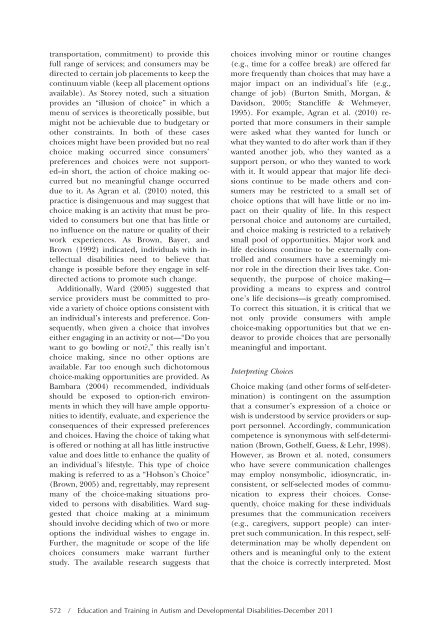etadd_46(4) - Division on Autism and Developmental Disabilities
etadd_46(4) - Division on Autism and Developmental Disabilities
etadd_46(4) - Division on Autism and Developmental Disabilities
Create successful ePaper yourself
Turn your PDF publications into a flip-book with our unique Google optimized e-Paper software.
transportati<strong>on</strong>, commitment) to provide this<br />
full range of services; <strong>and</strong> c<strong>on</strong>sumers may be<br />
directed to certain job placements to keep the<br />
c<strong>on</strong>tinuum viable (keep all placement opti<strong>on</strong>s<br />
available). As Storey noted, such a situati<strong>on</strong><br />
provides an “illusi<strong>on</strong> of choice” in which a<br />
menu of services is theoretically possible, but<br />
might not be achievable due to budgetary or<br />
other c<strong>on</strong>straints. In both of these cases<br />
choices might have been provided but no real<br />
choice making occurred since c<strong>on</strong>sumers’<br />
preferences <strong>and</strong> choices were not supported--in<br />
short, the acti<strong>on</strong> of choice making occurred<br />
but no meaningful change occurred<br />
due to it. As Agran et al. (2010) noted, this<br />
practice is disingenuous <strong>and</strong> may suggest that<br />
choice making is an activity that must be provided<br />
to c<strong>on</strong>sumers but <strong>on</strong>e that has little or<br />
no influence <strong>on</strong> the nature or quality of their<br />
work experiences. As Brown, Bayer, <strong>and</strong><br />
Brown (1992) indicated, individuals with intellectual<br />
disabilities need to believe that<br />
change is possible before they engage in selfdirected<br />
acti<strong>on</strong>s to promote such change.<br />
Additi<strong>on</strong>ally, Ward (2005) suggested that<br />
service providers must be committed to provide<br />
a variety of choice opti<strong>on</strong>s c<strong>on</strong>sistent with<br />
an individual’s interests <strong>and</strong> preference. C<strong>on</strong>sequently,<br />
when given a choice that involves<br />
either engaging in an activity or not—“Do you<br />
want to go bowling or not?,” this really isn’t<br />
choice making, since no other opti<strong>on</strong>s are<br />
available. Far too enough such dichotomous<br />
choice-making opportunities are provided. As<br />
Bambara (2004) recommended, individuals<br />
should be exposed to opti<strong>on</strong>-rich envir<strong>on</strong>ments<br />
in which they will have ample opportunities<br />
to identify, evaluate, <strong>and</strong> experience the<br />
c<strong>on</strong>sequences of their expressed preferences<br />
<strong>and</strong> choices. Having the choice of taking what<br />
is offered or nothing at all has little instructive<br />
value <strong>and</strong> does little to enhance the quality of<br />
an individual’s lifestyle. This type of choice<br />
making is referred to as a “Hobs<strong>on</strong>’s Choice”<br />
(Brown, 2005) <strong>and</strong>, regrettably, may represent<br />
many of the choice-making situati<strong>on</strong>s provided<br />
to pers<strong>on</strong>s with disabilities. Ward suggested<br />
that choice making at a minimum<br />
should involve deciding which of two or more<br />
opti<strong>on</strong>s the individual wishes to engage in.<br />
Further, the magnitude or scope of the life<br />
choices c<strong>on</strong>sumers make warrant further<br />
study. The available research suggests that<br />
choices involving minor or routine changes<br />
(e.g., time for a coffee break) are offered far<br />
more frequently than choices that may have a<br />
major impact <strong>on</strong> an individual’s life (e.g.,<br />
change of job) (Burt<strong>on</strong> Smith, Morgan, &<br />
Davids<strong>on</strong>, 2005; Stancliffe & Wehmeyer,<br />
1995). For example, Agran et al. (2010) reported<br />
that more c<strong>on</strong>sumers in their sample<br />
were asked what they wanted for lunch or<br />
what they wanted to do after work than if they<br />
wanted another job, who they wanted as a<br />
support pers<strong>on</strong>, or who they wanted to work<br />
with it. It would appear that major life decisi<strong>on</strong>s<br />
c<strong>on</strong>tinue to be made others <strong>and</strong> c<strong>on</strong>sumers<br />
may be restricted to a small set of<br />
choice opti<strong>on</strong>s that will have little or no impact<br />
<strong>on</strong> their quality of life. In this respect<br />
pers<strong>on</strong>al choice <strong>and</strong> aut<strong>on</strong>omy are curtailed,<br />
<strong>and</strong> choice making is restricted to a relatively<br />
small pool of opportunities. Major work <strong>and</strong><br />
life decisi<strong>on</strong>s c<strong>on</strong>tinue to be externally c<strong>on</strong>trolled<br />
<strong>and</strong> c<strong>on</strong>sumers have a seemingly minor<br />
role in the directi<strong>on</strong> their lives take. C<strong>on</strong>sequently,<br />
the purpose of choice making—<br />
providing a means to express <strong>and</strong> c<strong>on</strong>trol<br />
<strong>on</strong>e’s life decisi<strong>on</strong>s—is greatly compromised.<br />
To correct this situati<strong>on</strong>, it is critical that we<br />
not <strong>on</strong>ly provide c<strong>on</strong>sumers with ample<br />
choice-making opportunities but that we endeavor<br />
to provide choices that are pers<strong>on</strong>ally<br />
meaningful <strong>and</strong> important.<br />
Interpreting Choices<br />
Choice making (<strong>and</strong> other forms of self-determinati<strong>on</strong>)<br />
is c<strong>on</strong>tingent <strong>on</strong> the assumpti<strong>on</strong><br />
that a c<strong>on</strong>sumer’s expressi<strong>on</strong> of a choice or<br />
wish is understood by service providers or support<br />
pers<strong>on</strong>nel. Accordingly, communicati<strong>on</strong><br />
competence is syn<strong>on</strong>ymous with self-determinati<strong>on</strong><br />
(Brown, Gothelf, Guess, & Lehr, 1998).<br />
However, as Brown et al. noted, c<strong>on</strong>sumers<br />
who have severe communicati<strong>on</strong> challenges<br />
may employ n<strong>on</strong>symbolic, idiosyncratic, inc<strong>on</strong>sistent,<br />
or self-selected modes of communicati<strong>on</strong><br />
to express their choices. C<strong>on</strong>sequently,<br />
choice making for these individuals<br />
presumes that the communicati<strong>on</strong> receivers<br />
(e.g., caregivers, support people) can interpret<br />
such communicati<strong>on</strong>. In this respect, selfdeterminati<strong>on</strong><br />
may be wholly dependent <strong>on</strong><br />
others <strong>and</strong> is meaningful <strong>on</strong>ly to the extent<br />
that the choice is correctly interpreted. Most<br />
572 / Educati<strong>on</strong> <strong>and</strong> Training in <strong>Autism</strong> <strong>and</strong> <strong>Developmental</strong> <strong>Disabilities</strong>-December 2011
















